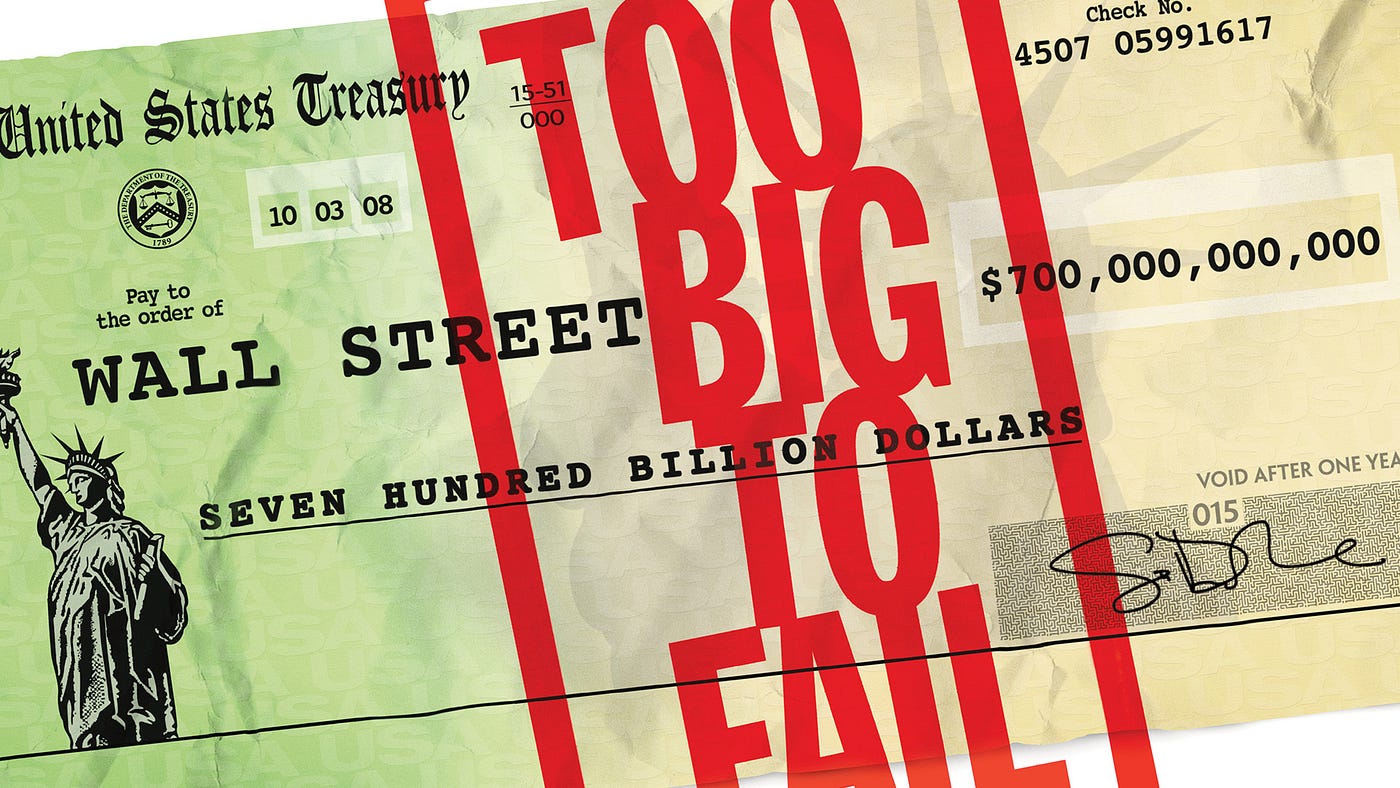“Too big to fail” describes a business or business sector so ingrained in a financial system or economy that its failure would be disastrous.
The government will consider bailing out a corporate entity or a market sector, such as Wall Street banks or U.S. carmakers, to prevent economic disaster.
KEY TAKEAWAYS
- “Too big to fail” describes a business or sector whose collapse would cause catastrophic economic damage.
- The U.S. government has intervened with rescue measures where failure poses a risk to the economy.
- The Emergency Economic Stabilization Act of 2008, following the failure of banks during the financial crisis of 2007-2008, included the $700 billion Troubled Asset Relief Program (TARP).
Financial Institutions
A bailout of Wall Street banks and other financial institutions deemed “too big to fail” occurred during the global financial crisis of 2007-2008. Following the collapse of Lehman Brothers, Congress passed the Emergency Economic Stabilization Act (EESA) in October 2008.
The rescue measures included the $700 billion Troubled Asset Relief Program (TARP), which authorized the U.S. government to purchase distressed assets to stabilize the financial system. Following the assistance, regulations under the Dodd-Frank Wall Street Reform and Consumer Protection Act of 2010 were imposed on financial institutions.
“Too big to fail” became a common phrase during the 2007–2008 financial crisis, which led to financial sector reform in the United States and globally.
Bank Reform
Following bank failures in the 1920s and early 1930s, the Federal Deposit Insurance Corp. (FDIC) was created to monitor banks, insure customer deposits, and assure Americans that their savings would be safe. The FDIC insures individual accounts in member banks for up to $250,000 per depositor.
The 21st century saw new challenges for banks, which had developed financial products and risk models that were inconceivable in the 1930s. The 2007–2008 financial crisis exposed unknown consumer and economic risks.
Dodd-Frank Act
Passed in 2010, Dodd-Frank was created to help prevent future financial system bailouts. It included new regulations regarding capital requirements, proprietary trading, and consumer lending. Dodd-Frank also imposed higher requirements for banks collectively labeled systemically important financial institutions (SIFIs).
Global Banking Reform
The 2007–2008 financial crisis affected banks around the world. Global regulators also implemented reforms, with most new regulations focused on “too big to fail” banks. Examples of global SIFIs include Mizuho, the Bank of China, BNP Paribas, Deutsche Bank, and Credit Suisse. Global bank regulations are led by the Basel Committee on Banking Supervision, the Bank for International Settlements, and the Financial Stability Board.
Companies Considered Too Big to Fail
Banks that the U.S. Federal Reserve (Fed) has said could threaten the stability of the U.S. financial system include:
- Bank of America Corp.
- The Bank of New York Mellon Corp.
- Citigroup Inc.
- The Goldman Sachs Group Inc.
- JPMorgan Chase & Co.
- Morgan Stanley
- State Street Corp.
- Wells Fargo & Co.
Other entities that were deemed as “too big to fail” during the financial crisis of 2007-2008 and required government intervention were:11
- General Motors (auto company)
- AIG (insurance company)
- Chrysler (auto company)
- Fannie Mae (government-sponsored enterprise (GSE))
- Freddie Mac (GSE)
- GMAC—now Ally Financial (financial services company)
15 years following the banking crisis of 2008, the big banks are bigger than ever. In early 2023, JPMorgan Chase took over the deposits and substantial assets from the failure of First Republic Bank.
Critique of the Too Big to Fail Theory
Numerous policies and regulations were imposed to prevent future financial disasters and curtail government intervention. The Dodd-Frank Act passed in July 2010 requires banks to limit their risk-taking by holding larger financial reserves. Banks must keep a ratio of higher-quality assets or capital requirements in the event of distress within the bank or the wider financial system.
The Consumer Financial Protection Bureau (CFPB) addressed the subprime mortgage crisis and implemented mortgage lending practices that make it easier for consumers to understand the terms of a mortgage agreement.
Critics have argued that regulations harm the competitiveness of U.S. firms and contend that regulatory compliance requirements unduly burden community banks and smaller financial institutions that did not play a role in the financial crisis.
In 2018, some provisions of Dodd-Frank were loosened under President Trump with the passage of the Economic Growth, Regulatory Relief, and Consumer Protection Act.
Is ‘Too Big to Fail’ a New Concept?
This term was publicized by U.S. Rep. Stewart McKinney (R-Conn.) in a 1984 congressional hearing, discussing the intervention of the Federal Deposit Insurance Corp. (FDIC) with the Continental Illinois bank. Although the term was previously used, it became more widely known during the global financial crisis of 2007 and 2008 when Wall Street received a government bailout.
What Protections Mitigate “Too Big To Fail”?
Regulations have been put in place to require systemically important financial institutions to maintain adequate capital and submit to enhanced supervision and resolution regimes.
After the 2008 collapse of large financial institutions, policies were enacted, including the Emergency Economic Stabilization Act of 2008 (EESA) and the Dodd-Frank Wall Street Reform and Consumer Protection Act of 2010.
How Did the Troubled Assets Relief Program Assist Banks That Were Too Big To Fail?
The EESA established the Troubled Assets Relief Program (TARP) authorizing the Treasury secretary to “purchase, and to make and fund commitments to purchase, troubled assets from any financial institution, on such terms and conditions as are determined by the secretary.” Proponents believed minimizing the economic damage created by the subprime mortgage meltdown was vital.
The Bottom Line
To protect the U.S. economy from a disastrous financial failure that might have global repercussions, the government may step in to financially bail out a systemically critical business or an economic sector, such as transportation or the auto industry. During the 2007-2008 global financial crisis, policymakers and regulators in the U.S. deemed some banks and corporations “too big to fail.” They provided rescue measures through the Emergency Economic Stabilization Act of 2008.





